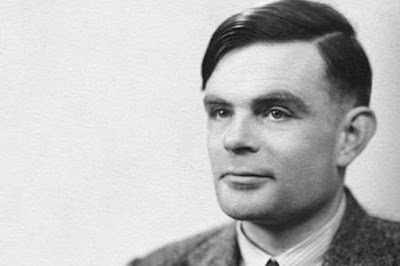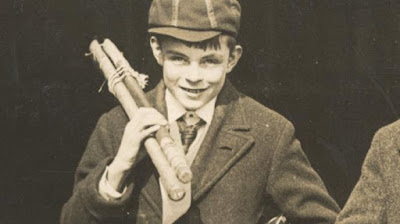Biography of Alan Turing. This British man cannot be separated from the historical development of computer technology. He is known for being a major role in the early pioneer development of the first digital modern computer and known as ' the father of computer science '. Here we present the profile and biography of Alan Turing.
Her full name was Alan Mathison Turing who was born in London on June 23, 1912. He was the second child of Julius Mathison Turing and Ethel Sara Stoney. He has an older brother named John. F Turing.
Alan Turing's father Julius Mathison Turing worked as a civil service officer in India when India was still in British rule. His own mother, Ethel Sara Stoney, was the son of a railway officer.
When containing Alan Turing, his parents demanded that Alan Turing be born in England hence they returned to England.
In the biography of Alan Turing It is known that when Alan Turing was six years old, he then entered St. Michael's elementary school, and at the school, Alan Turing began to demonstrate his genius and made his school head amazed at the genius of Alan Turing.
In his teenage years, he has read the works of Albert Einstein and then began to put his interest in the fields of natural sciences and mathematics.
And in 1926, Alan Turing was later entered at Sherborne School. Graduating from Sherborne School, Alan Turin then went on to study at Cambridge University in mathematics in 1931.
Alan Turing influenced the writings of Von Neumann, Russell, and Whitehead on mathematics and science, and on his campus, he was active in the peace movement.
In 1930, Alan Turing managed to create a machine called ' Turing Machine ' or the Turin engine, a machine that could run a simple set of commands that later became the forerunner of a modern computer.
Quoted from The book The History of Psychology by George Boeree, a Turing machine is a tool capable of transforming and manipulating basic abstract symbols.
The engine consists of a ribbon that can be used to read and write symbols on the Turing machine's ribbon and can also make the Ribbon a storage place.
However, the Turing machine is not limited to push and pop operations when accessing its storage media. Alan Turin also creates the concepts of computer science even when it is still unknown.
In 1934, Alan Turing then graduated from Cambridge University and thanks to his intelligence as well as his achievements, he then received a scholarship from Princeton University in the United States to pursue his doctorate and successfully completed it in 1936.
After completing his education, Alan Turin then returned to England and worked in the UK Department of Communications. When World War II raged from 1939 to 1945, he was tasked with solving the information on the Nazi Germany-made Enigma machine.
The British government than through his scientific team had designed a computer named ' Colossus Computer ' to help break the encrypted information from Nazi Germany. Colossus Computer was created by Tommy Flowers with the design of Alan Turing.
Not long after, Alan Turing managed to break the codes contained in the Enigma machine by creating another Enigma code breaker engine named ' The Bombe ' which was created in the year 1939 by Alan Turing.
In the movie titled ' The Imitation Game ' The name of the machine made by Alan Turing named ' Cristopher ' but the real name of the Enigma code-breaking machine, Alan Turing is The Bombe. This machine then became the early pioneer of the era of digital computers.
In the biography of Alan Turing, It is known that his enormous services to his country make him later awarded as a hero of war. After World War, Alan Turing then published a scientific paper titled ' Computing Machinery and Intelligence '.
In his writings, he proposed a method of whether a machine also has an ' Artificial Intelligence ' like a human brain which later it is known as the ' Turing test '.
During his lifetime, Alan Turing tried hard to make his creation machine the Turin machine can be an automatic computer machine in the National Physical Laboratory but it was never achieved.
He then moved to the University of Manchester and then there he made a guide for automatic computer machine MADAM (Manchester Automatic Digital Machine).
Later in 1954, Alan Turing had a problem, he was arrested by local police for accusations of sexual intercourse with a young man in which it was banned in England. Alan Turin is then punished by injected estrogen with the goal of neutralizing its hormones.
As a result of the incident, his reputation became devastated and he lost his job after much pressure from the public because he was known as a Gay (homosexual).
The continuous pressure from the public made Alan Turin then decided to commit suicide by eating apples containing cyanide poison in the house located in Winslow, England on June 7, 1954.
His recognition as a homosexual made the British Empire not to give forgiveness despite his reputation as a hero of war and a well-known scientist in England.
In 2013, Queen Elizabeth forgave herself after her death 60 years ago. Despite the behavior of Alan Turing, he is known to be a prominent figure in the development of digital computers and computer science, so he is nicknamed as ' father of computer science '.
Biography Alan Turing
Her full name was Alan Mathison Turing who was born in London on June 23, 1912. He was the second child of Julius Mathison Turing and Ethel Sara Stoney. He has an older brother named John. F Turing.
Alan Turing's father Julius Mathison Turing worked as a civil service officer in India when India was still in British rule. His own mother, Ethel Sara Stoney, was the son of a railway officer.
When containing Alan Turing, his parents demanded that Alan Turing be born in England hence they returned to England.
Alan's childhood Turin
In the biography of Alan Turing It is known that when Alan Turing was six years old, he then entered St. Michael's elementary school, and at the school, Alan Turing began to demonstrate his genius and made his school head amazed at the genius of Alan Turing.
In his teenage years, he has read the works of Albert Einstein and then began to put his interest in the fields of natural sciences and mathematics.
And in 1926, Alan Turing was later entered at Sherborne School. Graduating from Sherborne School, Alan Turin then went on to study at Cambridge University in mathematics in 1931.
Alan Turing influenced the writings of Von Neumann, Russell, and Whitehead on mathematics and science, and on his campus, he was active in the peace movement.
Create a Turing Machine
Quoted from The book The History of Psychology by George Boeree, a Turing machine is a tool capable of transforming and manipulating basic abstract symbols.
The engine consists of a ribbon that can be used to read and write symbols on the Turing machine's ribbon and can also make the Ribbon a storage place.
However, the Turing machine is not limited to push and pop operations when accessing its storage media. Alan Turin also creates the concepts of computer science even when it is still unknown.
In 1934, Alan Turing then graduated from Cambridge University and thanks to his intelligence as well as his achievements, he then received a scholarship from Princeton University in the United States to pursue his doctorate and successfully completed it in 1936.
Also Read: Biography Thomas Edison Inventions Light Bulb
Making The Enigma Code breaker machine Colossus and The Bombe
After completing his education, Alan Turin then returned to England and worked in the UK Department of Communications. When World War II raged from 1939 to 1945, he was tasked with solving the information on the Nazi Germany-made Enigma machine.
The British government than through his scientific team had designed a computer named ' Colossus Computer ' to help break the encrypted information from Nazi Germany. Colossus Computer was created by Tommy Flowers with the design of Alan Turing.
Not long after, Alan Turing managed to break the codes contained in the Enigma machine by creating another Enigma code breaker engine named ' The Bombe ' which was created in the year 1939 by Alan Turing.
Also Read: Biography Google Larry Page Founder Google Inc
Pioneer's creation of Digital computers
In the biography of Alan Turing, It is known that his enormous services to his country make him later awarded as a hero of war. After World War, Alan Turing then published a scientific paper titled ' Computing Machinery and Intelligence '.
In his writings, he proposed a method of whether a machine also has an ' Artificial Intelligence ' like a human brain which later it is known as the ' Turing test '.
During his lifetime, Alan Turing tried hard to make his creation machine the Turin machine can be an automatic computer machine in the National Physical Laboratory but it was never achieved.
He then moved to the University of Manchester and then there he made a guide for automatic computer machine MADAM (Manchester Automatic Digital Machine).
Also Read: Biography Sergey Google Story Founder Google
End of Life Alan Turing
As a result of the incident, his reputation became devastated and he lost his job after much pressure from the public because he was known as a Gay (homosexual).
The continuous pressure from the public made Alan Turin then decided to commit suicide by eating apples containing cyanide poison in the house located in Winslow, England on June 7, 1954.
His recognition as a homosexual made the British Empire not to give forgiveness despite his reputation as a hero of war and a well-known scientist in England.


